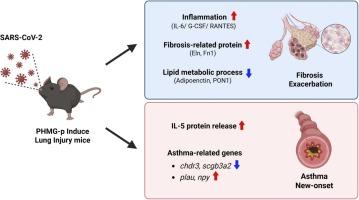SARS-CoV-2感染可加重聚六亚甲基胍磷酸损伤肺的纤维化并发展为新发哮喘
IF 11.3
1区 环境科学与生态学
Q1 ENGINEERING, ENVIRONMENTAL
引用次数: 0
摘要
由于化学品使用的增加和传染病的周期性爆发,现代社会面临着各种与呼吸有关的威胁。本研究探讨了化学诱导的肺损伤与SARS-CoV-2感染之间的联系,填补了一个关键的研究空白。为了研究这种联系,我们使用小鼠模型来评估聚六亚甲基胍-磷酸(PHMG-p)损伤肺部的SARS-CoV-2感染症状。我们的研究表明,phmg -p诱导的肺损伤(PILI)小鼠在感染后表现出严重的炎症反应和肺损伤。细胞因子风暴相关因子在感染的PILI小鼠支气管肺泡灌洗液中显著升高,表明感染严重。RNA-seq分析显示,感染的PILI小鼠中基因上调与呼吸道疾病相关,炎症和免疫反应增加。下调的基因主要参与脂质代谢过程。我们还在感染的PILI小鼠中发现了与哮喘发展相关的四个_基因的改变,这与患者的临床观察相关联。我们的研究结果表明,在化学损伤的肺部感染SARS-CoV-2可能会加剧症状,并可能导致新发哮喘。这项研究强调了化学损伤肺部感染严重程度的风险增加,并强调需要提高接触化学品个体的呼吸健康意识,特别是在传染病暴发期间。本文章由计算机程序翻译,如有差异,请以英文原文为准。

SARS-CoV-2 infection exacerbates fibrosis and develops new-onset asthma in damaged lung by polyhexamethylene guanidine phosphate
Modern society faces a variety of respiratory-related threats from the increased use of chemicals and periodic outbreaks of infectious diseases. This study investigates the connection between chemically-induced lung damage and SARS-CoV-2 infection, addressing a critical research gap. To investigate this connection, we conducted a study using a mouse model to assess SARS-CoV-2 infection symptoms in lungs injured by polyhexamethylene guanidine phosphate (PHMG-p). Our research revealed that PHMG-p-Induced Lung Injury (PILI) mice exhibited severe inflammatory responses and lung damage following infection. Cytokine storm-related factors were significantly elevated in the bronchoalveolar lavage fluids of infected PILI mice, indicating severe infection. RNA-seq analysis showed upregulated genes in infected PILI mice associated with respiratory tract diseases and increased inflammatory and immune responses. Downregulated genes were primarily involved in lipid metabolism processes. We also identified alterations in four _genes linked to asthma development in infected PILI mice, correlating with clinical observations in patients. Our findings suggest that SARS-CoV-2 infection in chemically damaged lungs may exacerbate symptoms and potentially lead to new-onset asthma. This study highlights the increased risk of infection severity in chemically damaged lungs and emphasizes the need for heightened awareness of respiratory health in individuals exposed to chemicals, especially during infectious disease outbreaks.
求助全文
通过发布文献求助,成功后即可免费获取论文全文。
去求助
来源期刊

Journal of Hazardous Materials
工程技术-工程:环境
CiteScore
25.40
自引率
5.90%
发文量
3059
审稿时长
58 days
期刊介绍:
The Journal of Hazardous Materials serves as a global platform for promoting cutting-edge research in the field of Environmental Science and Engineering. Our publication features a wide range of articles, including full-length research papers, review articles, and perspectives, with the aim of enhancing our understanding of the dangers and risks associated with various materials concerning public health and the environment. It is important to note that the term "environmental contaminants" refers specifically to substances that pose hazardous effects through contamination, while excluding those that do not have such impacts on the environment or human health. Moreover, we emphasize the distinction between wastes and hazardous materials in order to provide further clarity on the scope of the journal. We have a keen interest in exploring specific compounds and microbial agents that have adverse effects on the environment.
 求助内容:
求助内容: 应助结果提醒方式:
应助结果提醒方式:


